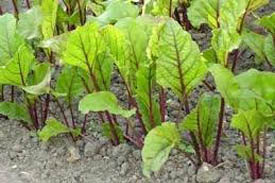Gardening: King of Taste – Horseradish
 Diane threw up her hands in dismay and said, “Good gosh oh’ mighty, get that stuff out of my kitchen.”
Diane threw up her hands in dismay and said, “Good gosh oh’ mighty, get that stuff out of my kitchen.”
Humph! “Diane has no appreciation for the finer garden treats,” I mumbled to myself as I gathered up the yard long horseradish roots, food processor and jars.
“I’ll do the processing in the canning kitchen outside,” I said and left her with weeping eyes and red nose from the pungent tear gas effects of processing one of nature’s finest condiments for the table.
I like horseradish. It seems as if men are the only ones I know of who like horseradish; so this article if dedicated to the men folk who are lovers of great food everywhere. The women can stay with their delicate mustards for a condiment; men will rally around horseradish.
Horseradish – Nasturtium armoracia or Amorcia lapthifolia is a perennial herb of the Gruiferae, cultivated by the Greeks before the roman conquest of the British Isles more than 3,000 years ago. It is still popular in central Europe, Britain, and the Alpine regions of Italy and Switzerland. Even the Middle Eastern countries have found favor with this famous condiment for the table.
Horseradish is alleged to have been one of the bitter herbs used by the Jews during Passover, and it has an ancient history as a cure for rheumatism when taken with vinegar. It is though to be diuretic and antiscorbutic by many authorities. In the old days, it was a reported treatment for colds, the honey and horseradish juice being mixed together.
Today horseradish is considered to be a pungent herb that will flavor meat and fish dinners tenfold. The weak and ineffectual horseradish purchased over the counter has no comparison with the real fresh root that is finely chopped and blended with vinegars, herbs and creams to make your palate take notice – and your wife’s eyes water.
There are many ways to prepare horseradish, the foremost thought being to harvest the deep diving roots in the fall after a couple of hard frosts, or certainly before early spring when the crowns start to send up new leaves. You will want to dig deep to get all of the roots, some go down five to ten feet, although three feet is more common and as deep as anyone wants to dig for. The easiest propagation method is to dig the entire plant in the late fall and replant all over again in the spring with the excess pieces of leftover roots. Horseradish is only started from root divisions, never from seed.
Wash the roots in a bucket. They will be from pencil thickness to upwards of an inch across. Remove the woody pieces, and use the supple roots. I have taken to using a food processor. I grate the roots quickly and easily. If you are immune to the tear gas effects, like most manly men are, then you can grate it in the kitchen. However, other family members may request that you go elsewhere, or do it while they are out shopping. An old meat grinder works well, or you can chop it fine with a cleaver. Another option is to use a cheese grater.
Once the roots are chopped, grated fine, all you need to do is stuff them into jars, and add vinegar and water. Seal tightly and store in the refrigerator, where it will keep for several months. As it ages, it loses pungency.
Some people like to add about ½ cup heavy cream to 2 to 4 tablespoons of horseradish for meat dishes. Adventurous souls may experiment with the addition of blended mustards. A very old recipe, from the 1700’s when beef reigned supreme in the English households, was ½ cup of horseradish mixed with a pint of beef broth, two eggs (today raw eggs are NOT recommended) and a spoonful of garden grown tarragon vinegar. Add salt and pepper, serve cold with a mayonnaise base.
From the gardener’s standpoint, where you plant is important. It will become a pest in the garden, if you do not dig out all the small rootlets. Remember they go deep and wide. Old-time gardeners, who used to grow repetitive crops in the same spot before rotation became popular, often interplanted horseradish with potatoes and cabbage, since it is a deterrent to beetles. In this day and age, I think that the Japanese method of growing deep root plants would be worth considering by the Country Gardener.
Acquire a large stack of old fence posts or logs that you can easily handle. Stack them, Lincoln log fashion, in a square perhaps four feet across and three feet high. Another option is to make a big box from scrap boards. Fill the “box” with good garden loam that has a cup of fine sifted wood ash mixed in. Now take a root section and look at it. If acquired from a nursery, it will have one end out on a diagonal and the other end square across. Plant the diagonal end two inches below the soil. Plant four or five roots in this raised box method. Keep the box watered in the summer. This following fall you can disassemble the box easily and gain the roots with no spreading to the garden. If you forget this year, let it continue to grow another season. Just remember that the stacked box method requires more water than the regular garden in the summer months.
You can use the excess grated roots and even the leaves as an excellent “bug repellant” in the garden, especially on potatoes and cabbage. Just soak some grated roots in water for a couple of days, strain, add a tablespoon or two of liquid soap, the spray or dribble on the plants. Watch the bugs disappear.
Sprouting the horseradish crowns in a dark, warm, moist environment can make a very nice extra early green for your winter salad. The leaves will be white, tender and sweet. Green leaves are bitter. Cut the leaves when about three inches long. I put my crowns in a bucket of moist sand in the dark root cellar. I suspect that the refrigerator would do as well if you wrap the crowns in plastic. Bon appetite.
God Bless
Copyright: 2009, Back2theLand.com, Mark Steel



